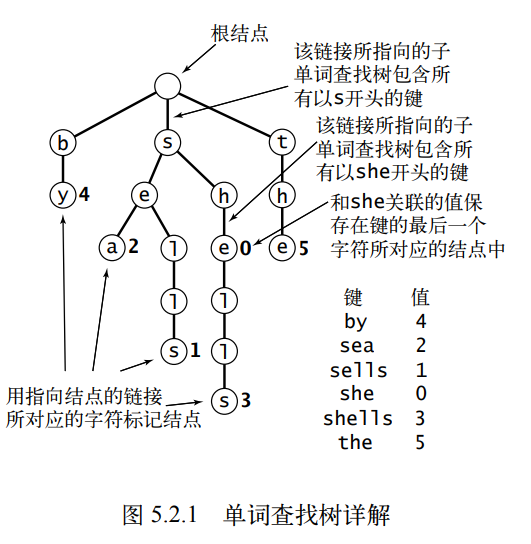【算法4】5.2.单词查找树
单词查找树
单词查找树适用于以字符串为键的查找算法。
性能:
- 查找命中所需的时间与被查找的键的长度成正比
- 查找未命中只需检查若干个字符
以字符串为键的符号表的 API:
public interface StringST<Value> {
void put(String key, Value val); // 键为 null 表示删除键
Value get(String key);
void delete(String key);
boolean isEmpty();
String longestPrefixOf(String s); // 返回一个最长的键,该键是 s 的前缀
Iterable<String> keysWithPrefix(String s); // 返回以 s 为前缀的所有键
Iterable<String> keysThatMatch(String s); // 返回所有匹配的键,字符 . 表示任意字符
int size();
Iterable<String> keys();
}
单词查找树由结点组成。
每个结点含有 R 条链接和一个可选的值。(R 是字符集大小,这种单词查找树也叫 R 向单词查找树)
一个结点通常会含有大量的空链接,在绘制单词查找树时会忽略这些空链接。
在单词查找树中,值保存在键对应的尾结点中。

private static class Node {
Object val; // 节点保存的值
Node[] next = new Node[R]; // 指向子节点的指针
}
单词查找树实现:
public class Trie <Value>{
private static final int R = 128; // ASCII 字符集大小
private Node root;
private static class Node {
Object val; // 节点保存的值
Node[] next = new Node[R]; // 指向子节点的指针
}
public void put(String key, Value val) {
root = put(key, val, root, 0, key.length());
}
private Node put(String key, Value val, Node node, int cur, int len) {
if (node == null) {
node = new Node();
}
if (cur == len) {
node.val = val;
} else {
char c = key.charAt(cur);
node.next[c] = put(key, val, node.next[c], cur + 1, len);
}
return node;
}
public Value get(String key) {
Node node = get(key, root, 0, key.length());
if (node == null) {
return null;
}
return (Value) node.val;
}
private Node get(String key, Node node, int cur, int len) {
if (node == null) {
return null;
}
if (cur == len) {
return node;
}
return get(key, node.next[key.charAt(cur)], cur + 1, len);
}
}




 浙公网安备 33010602011771号
浙公网安备 33010602011771号